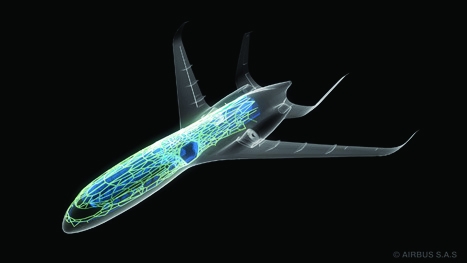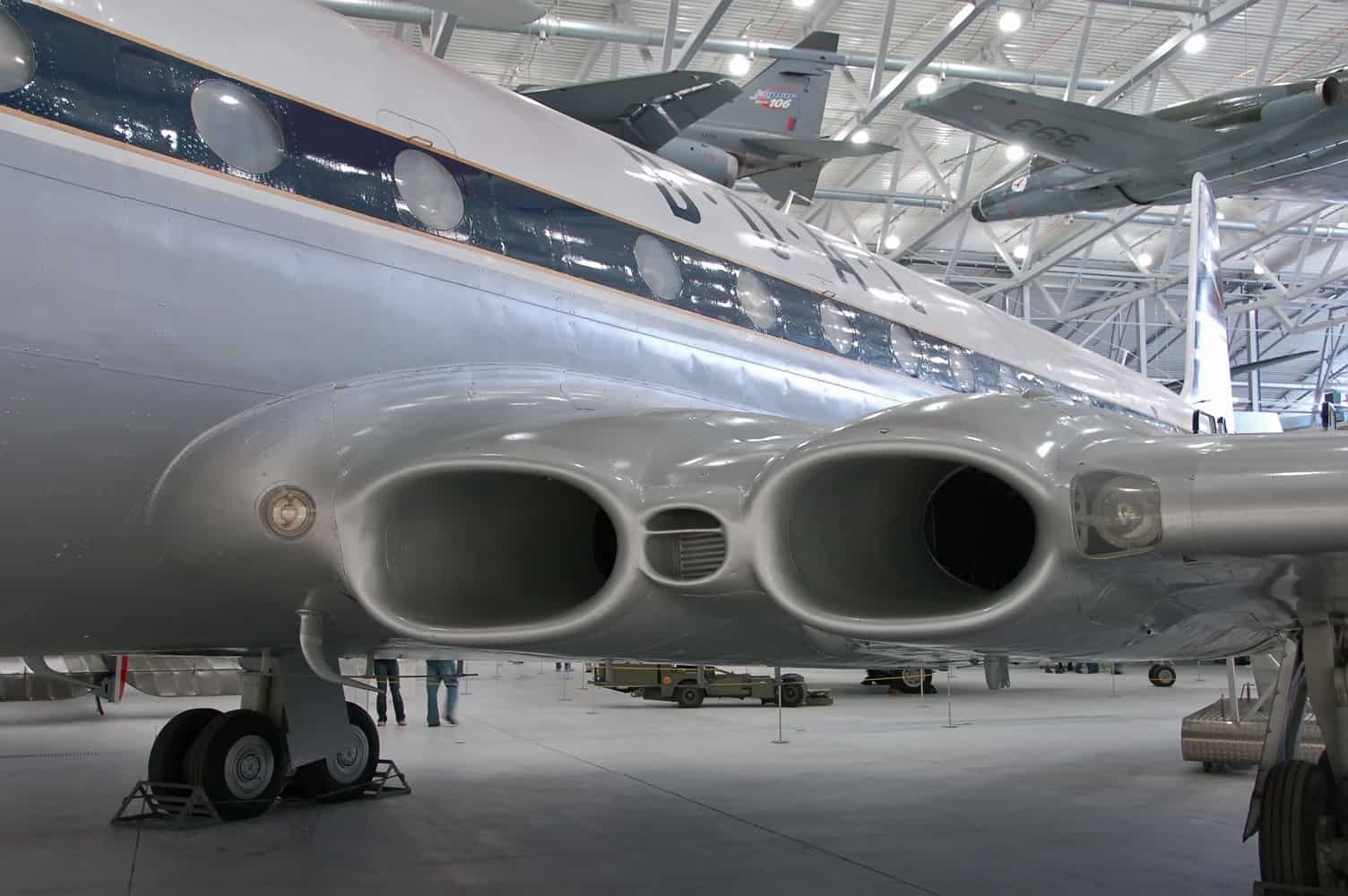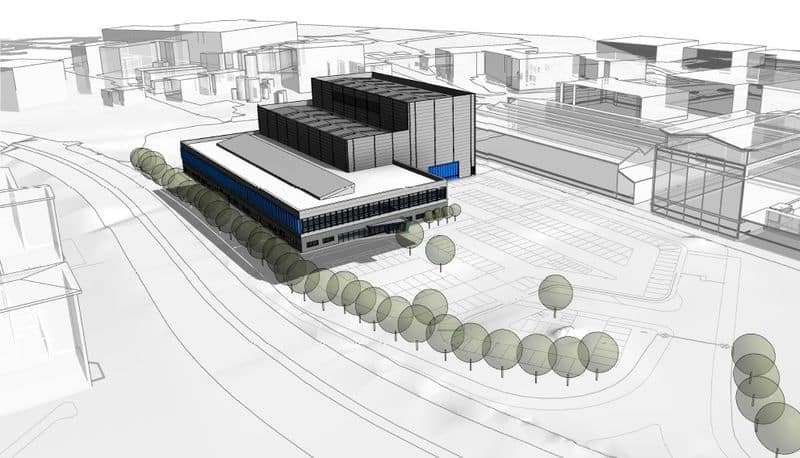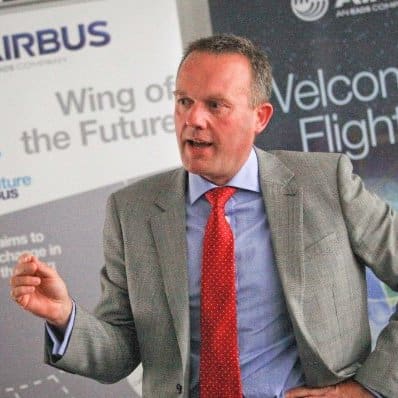Mark Howard
Head of R&T Business Development and Partnerships UK at Airbus Group
Education
- 1985 BSc in Aerospace, Aeronautical and Astronautical/Space Engineering, University of Bath
Career
- 1985 fight test data engineer, Westland Helicopters
- 1986 structural dyamics and aeroelastics test engineer, Airbus
- 1994 R&T portfolio manager, optimised wing and supersonics, Airbus
- 1997 project leader, A340-500/600 landing gear and lading gear systems, Airbus
- 2003 head of A380 landing gear structures, Airbus
- 2008 head of loads and aeroelastics UK, Airbus
- 2011 head of aircraft loads, trans-national, Airbus
- 2014 head of overall integration A330neo, Airbus
Mark Howard, head of R&T, business development and partnerships for Airbus in the UK, was in an optimistic mood after finishing his presentation at the Collaborate to Innovate conference in Coventry late last year. He told The Engineer: “I think we really are on the cusp of some big changes.” His presentation had been full of images of Airbus’s concept for a future generation of civil aircraft, as well as the company’s speculation on how future airports might operate.
Howard’s role within the company, he says, is as much about how Airbus innovates as the areas in which it innovates, which is more within the purview of the chief technology officer’s department. “My role is about Airbus aircraft and what we can do from a collaborative perspective and how we will progress research and technology in a collaborative way; making sure we have the right partners in place and the right technology programmes in place to deliver on some key targets,” he said. “But if you peel back the skin, so to speak, I’m an engineer at heart; I speak to engineers every day.”

The most striking thing about the future designs Howard was discussing is that rather than have the engines slung under the wing in the fashion that has been prevalent in civil aircraft for decades now, the new designs have the engine integrated into the airframe of the aircraft, housing them inside fairings mounted against the underside of the fuselage between the trailing edge of the wing and the leading edge of the tailplane, shaped quite differently from that of today’s aircraft. “The integrated power plant enables you to produce better products,” Howard said. “The question is that if today you have a system that is effectively bolted onto the structure, can you make it an integral part of the structure so it effectively becomes a dual-use structure?”
New structures inevitably present new problems. Integrating engines so that they are closer to the airframe of the aircraft means they have to cope with the boundary layer of air and the way it flows past the aircraft skin; a more complex situation than an engine slung under the wing and effectively outside the boundary layer. This is one area where collaboration is very important, and Howard mentioned that Airbus habitually works very closely with Rolls-Royce and other engine manufacturers. “We have to always become more efficient in collaboration and design productivity and how we share information so that we drive the design forward together,” he said. “In an area [such as] this, we will be working with our engine manufacturers right from the start, so we wouldn’t have a situation where we were just present them with data on the boundary layer that the engine would be expected to cope with.”
Another important aspect of more integrated engines is how they affect the maintenance of the aircraft, and this is something that Airbus has very much in mind, Howard said. “That is one of our key challenges,” he conceded. “If you go back to the cash operating cost for the airline, the maintenance cost is a key driver, as is the turnaround time for maintenance. So whatever we do, we have to think about not only a product that performs well but can also be maintained and turned around really quickly. It drives the airline cost and it also drives the frustration of passengers. But,” he added, “if you look at the operation of our single-aisle and long-range aircraft, it’s phenomenal; up in the 95.5 per cent region.”

Highly integrated engines are, of course, not a new feature of aircraft. Early generations of single-seat military jet fighters had engines integrated into housings at the wing root, as did the UK’s ‘V-bomber’ fleet of nuclear-weapon-carrying aircraft, such as the Vulcan and Victor. The first jet airliner, the de Havilland Comet, also had airframe-integrated engines, with sleek cylindrical housings built into, rather than under, the wing. “Of course, that is knowledge that we would be taking forward in our new designs, but there will inevitably be differences because today’s engines are much more advanced than the ones associated with those mid-20th-century designs,” Howard said. “New engines have much higher bypass ratios for fuel economy, so they look very different, tending to have a much bigger diameter, and they handle air differently.”
Another idea presented as part of the future airport function is that, rather than taking off under their own power, aircraft would be sped along the runway by a catapult system, somewhat similar to those found on aircraft carriers but mounted onto the runway itself. “Catapult launch is about trying to challenge thinking,” Howard said. “If you’re trying to get aircraft off the ground, you need a certain thrust to achieve your target altitude within the target time. And if you can avoid having to use the engine for that, because take-off thrust is the biggest challenge for the engine, then we can reduce the size of the engine, reduce the weight, which means you don’t need as much lift, and therefore less drag, and reduce the size of the engine again.” Reducing engine size is a key strategy for reducing fuel consumption, and it’s a goal that aerospace shares with the automotive industry.
“Using catapult launch also allows you to think about the trajectory of the aircraft, which has a big impact on the noise footprint around the airport. Getting it into the air and to service height quicker means that the noise of the engines at full output affects a smaller area. Reducing noise is something that we are, of course, very concerned about and is a focus of our design efforts.”
The automotive sector is an important inspiration for aerospace, Howard said. Techniques such as 3D printing are a case in point, and aerospace companies have been looking at additive manufacture for some time. For example, GE uses additive techniques to make fuel-injection nozzles for its engines. For the aircraft integrators – which is how companies such as Airbus see themselves – 3D printing is currently confined to the secondary structure of the aircraft; that is to say components that do not carry the great structural stresses of holding the aircraft together. Bulkhead walls within the cabin are among the additive structures being tested by Airbus. “I think we have to go through a learning curve with the secondary structures and learn from that before we start looking at primary structure with 3D printing,” Howard said. “As long as you have the right traceability and the right process control and you can prove that you have the same or better performance from a conventional component, I don’t see why we can’t use 3D printing. Of course, the certification of the process and the component are vital.”

This means that older conceptual targets for 3D printing at Airbus, such as printing a whole wing, are almost certainly not practical, Howard said. “Wings are mostly made out of carbon these days, and that lends itself to different production techniques. In terms of an actual printed wing I really would struggle with that as a target. However, that’s not to say that some of the components of the systems inside the wing couldn’t be produced by additive techniques.”
Hand in hand with development of the aircraft themselves comes development of the way they are built, and any visitor to an Airbus production facility will see increased numbers of robotic cells carrying out assembly and material machining such as drilling and milling. Airbus is pioneering data sharing between management systems and the shop floor, such as using tools that pick up information about how they should be operating at particular locations on the aircraft and, in particular, tasks in the production chain. The two areas of development feed into each other, Howard explained, but compromise is a vital part of this process. “There might be ideas that you want to drive at an aircraft configuration level that are just not practical, by which I mean not cost-effective, to build. You have to optimise to find something that is acceptable from a performance level and also from a production level.”
However, Howard thinks it is vital for UK industry to import these new digital techniques as soon as possible. “It isn’t politic to say that we that we really need to get Industry 4.0, whatever we’re calling it, underway in the UK because the benefits will be huge, in terms of efficiency, reducing production costs and increasing productivity staff. But it is going to be a big change for many producers, and it’ll probably need government intervention, as it did in Germany, to help companies in the supply chain to get on board.”
But, ultimately, new design paradigms will depend on whether the customers of companies such as Airbus – the airlines – will buy them. “Whether the airlines would be reluctant or if the flying passenger would be reluctant is an interesting question,” Howard mused. “But the passenger probably wouldn’t care unless increased fuel economy meant the tickets were cheaper. Design changes in the aircraft are unlikely to affect the flying experience so much, although factors such as the way the aircraft deal with gusts of wind in turbulence could make flying more comfortable





Project to investigate hybrid approach to titanium manufacturing
What is this a hybrid of? Superplastic forming tends to be performed slowly as otherwise the behaviour is the hot creep that typifies hot...